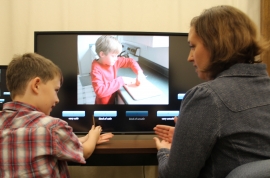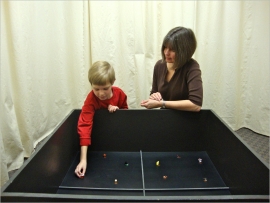Breadcrumb
- Home
- Research Highlights
Research Highlights
Mother-child conversations about safety: Implications for socializing safety values in children
January 16, 2014 - 12:00am
Abstract

This study examined how mothers socialize their children about safety through conversations about potentially unsafe activities. Mothers and their 8- and 10-year-old children discussed and rated the safety of 12 photographs depicting another same-gender child engaged in potentially dangerous activities. Conversations usually unfolded with children giving the first rating or rationale, followed by additional discussion between the mother and child. Mothers and children relied on 2 main types of rationales to justify their ratings: potential outcomes of the activity and specific features of the situation (dangerous and nondangerous). Mothers (but not children) used dangerous feature rationales more often than dangerous outcome rationales. When disagreements arose, mothers typically guided children to adopt their own rating rather than the child's rating. Additionally, children who used more nondangerous feature and outcome rationales had experienced more injuries requiring medical attention. Mothers' focus on dangerous features appears to reflect their efforts to help children make causal connections between dangerous elements of the situation and adverse outcomes that might result.
To read the full paper:
Perceiving and acting on complex affordances: How children and adults bicycle across two lanes of opposing traffic
Wednesday, December 4, 2013 - 12:00am
Abstract

This investigation examined how children and adults negotiate a challenging perceptual-motor problem with significant real-world implications – bicycling across two lanes of opposing traffic. Twelve- and 14-year-olds and adults rode a bicycling simulator through an immersive virtual environment. Participants crossed intersections with continuous cross traffic coming from opposing directions. Opportunities for crossing were divided into aligned (far gap opens with or before near gap) and rolling (far gap opens after near gap) gap pairs. Children and adults preferred rolling to aligned gap pairs, though this preference was stronger for adults than for children. Crossing aligned versus rolling gap pairs produced substantial differences in direction of travel, speed of crossing, and timing of entry into the near and far lanes. For both aligned and rolling gap pairs, children demonstrated less skill than adults in coordinating self and object movement. These findings have implications for understanding perception-action-cognition links and for understanding risk factors underlying car-bicycle collisions.
To read the full paper:
Mother-child conversations about safety: Implications for socializing safety values in children
December 4, 2013 - 12:00am
Abstract

We conducted two experiments to examine how mothers structure directions to young children for finding hidden objects and how young children use these directions to guide their searches. In Experiment 1, we examined the reference frames mothers use to communicate with their 2.5-, 3.0-, and 3.5-year-old children about location by asking mothers to verbally disambiguate a target hiding container from an identical non-target hiding container. We found that mothers’ reference frame use was primarily governed by the relative proximity of the target container to the landmark and themselves. Older children were more successful in following directions than were younger children, and children were more likely to search successfully in response to a person than to a landmark frame of reference. In Experiment 2, we further investigated how 3-year-old children follow directions involving person and landmark frames of reference by asking mothers to use either only themselves or only the landmark to describe the target location. Children in the person reference frame condition successfully followed their mother’s directions when the target was relatively close to the mother, but not when the target was relatively far from the mother. Children in the landmark reference frame condition were unsuccessful at following directions regardless of the relative proximity of the target to the landmark. The discussion focuses on the roles of spatial proximity and reference frames in mother-child spatial communication.
To read the full paper: